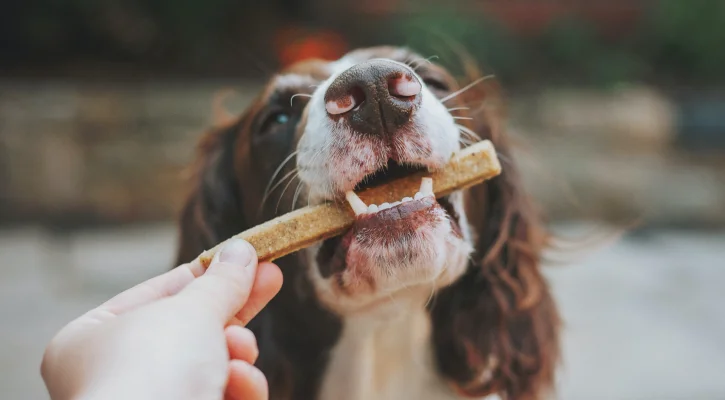Cat and Dog Teeth Cleaning in Boca Raton, FL
Improving Pet Oral Care
Your pet’s teeth need to be treated with the same care as your own. A majority of dogs and cats ages 3 and up have some form of dental disease, be it gingivitis or periodontal disease. Because poor oral hygiene is so common among pets, we believe it’s more important than ever to develop a dental routine at home with your pet, and to consult with us annually to see if they need a teeth cleaning. At Boca Palms Anima Hospital, Boca Raton, FL, our veterinary team is able to provide a full range of cat and dog teeth cleaning services to treat and prevent various dental diseases.
With ongoing dental care at home and with us, your pet will have better oral health and a much better quality of life.
Did You Know?
0
of cats over age 3 have dental disease
0
of dogs over age 3 have dental disease
0
TREATS GIVEN
Signs Your Pet Might Need to Have a Professional Teeth Cleaning
Often, dogs and cats won’t show that they’re struggling with oral pain. Still, there are a few signs you can look for to determine whether a visit to the vet is necessary:
- Noticeably bad breath
- Red, swollen gums
- Yellow/brown buildup on the teeth along the edge of the gum line
- Dropping food and/or eating less than usual
- Eating awkwardly (smacking their lips, sticking tongue out)
- Drooling
- Blood-tinged saliva
- Loose or broken teeth
How to Clean Your Pet’s Teeth at Home
The most effective way to slow plaque and tartar buildup is to brush your pet’s teeth daily (if possible). All you need is a pet tooth brush, pet-friendly toothpaste, and some patience. If you start when your pet is still a puppy or kitten, they will grow accustomed to the procedure more quickly.
First, get them used to having their teeth and gums touched, and then introduce the toothbrush. Let your pet taste the toothpaste first, too. To brush, just gently move the toothbrush in a circular motion along their gum line, without pressing too hard. Be sure to reward your pet for their good behavior, and take your time. You can always call us if you need help!
Steps of Our Cat and Dog Teeth Cleaning Procedure
Here at Boca Palms, we take a very thorough approach to your pet’s dental care. For a typical cat or dog teeth cleaning procedure, we follow these crucial steps:
- A standard physical exam
- A thorough oral exam with your pet under general anesthesia
- Full-mouth digital X-rays to assess oral health below the gums
- Probing and irrigating the periodontal pockets (around the teeth)
- Ultrasonic scaling to remove calculus from the crowns of the teeth and below the gum line
- Teeth polishing
- Tooth extractions (if needed)
- Fluoride treatment
- Dental charting
- Home care instructions provided to show our dental care recommendations for your pet’s needs
Do dental checkups always require anesthesia?
YES! While many owners would prefer to avoid procedures involving anesthesia – especially in older dogs – anesthesia-free dental cleanings are not recommended by the American Animal Hospital Association or American Veterinary Dental College. Anesthesia-free procedures always result in suboptimal examination and cleaning and also increase the risk of injury to a dog’s mouth.
Safe anesthesia for your pet
Your veterinarian will provide the following to ensure a safe anesthesia for your pet:
- A thorough examination and pre-anesthetic blood work to detect problems with infection or malfunctioning organs
- Anesthesia drugs selected based on your pet’s age, breed, health status and the procedure being performed. Quick-acting IV anesthetics and certain anesthetic gases are often preferred.
- Intravenous catheters to provide fluids to prevent dehydration, support blood pressure and provide pain medications for your pet’s comfort.
- A soft tube (endotracheal tube) placed in his or her windpipe during anesthesia to prevent any fluid from blocking the airway during the dental procedure.
- Special equipment to monitor your dog’s blood pressure, temperature, pulse, breathing, heart rate and heart rhythm during anesthesia to help minimize complications.
Veterinary anesthesia specialists all agree that dental health should not be neglected in any pet – even seniors – because dental disease often results in tooth and gum infections, pain, loss of teeth and even organ damage. However, if you are worried about putting your pet under anesthesia, you are not alone! Don’t hesitate to speak to your veterinarian and alert them to your concerns. Ask your veterinarian to describe the details of the dental procedure and about how your pet will be monitored during and after anesthesia.
We’ll notify you before we perform any extractions, and your pet will receive appropriate pain medication to lessen their discomfort.
It’s important to instill healthy dental habits at home to slow plaque and tartar formation and extend the amount of time between professional teeth cleanings. Puppies and kittens adjust quickly to routines and brushing your pet’s teeth every day will become second nature. However, if your pet is resistant to brushing, you can also try:
- A tartar control diet (available for dogs and cats)
- Oral care wipes (gauze and pet toothpaste are also effective)
- Bacteria-killing water additives
- Dental chews (for dogs)
- Dental treats (for cats)
